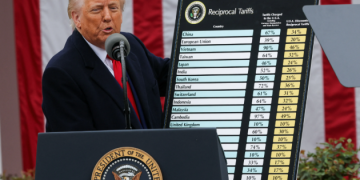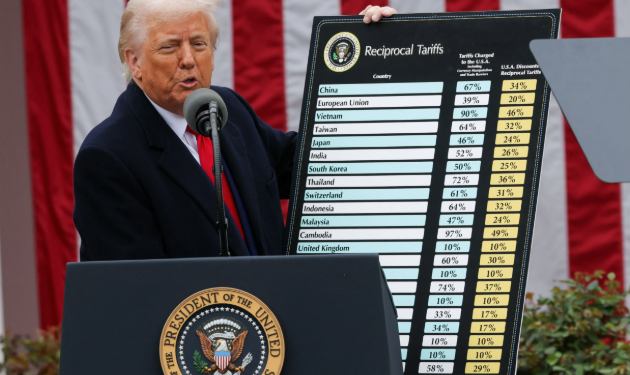By Eva Richardson | Published on April 4, 2025
In a dramatic escalation of trade policy, President Donald Trump has unveiled a sweeping set of tariffs poised to reshape global commerce and air cargo flows. Dubbed “Liberation Day” by the president, the announcement includes a universal 10% import tariff effective April 5, with significantly higher rates imposed on key trading partners — most notably China (34%), Vietnam (46%), Taiwan (32%), and the European Union (20%) beginning April 9.
In tandem with this sweeping tariff initiative, Trump also confirmed the long-anticipated end of the de minimis exemption for Chinese packages — a move that could profoundly affect e-commerce supply chains, cross-border delivery, and air cargo demand.
Tariffs Hit Fast and Hard
The new tariff regime, announced with only days’ notice, has stunned markets and logistics stakeholders. While some countries are scrambling to secure exemptions, the compressed timeline offers little room for maneuver. Chinese goods, in particular, are now subject to layered duties: the new 34% tariff comes on top of existing Section 301, the 20% March tariff, and baseline U.S. import duties.
Additionally, the automotive sector faces a 25% tariff on imported vehicles starting immediately, with auto parts facing the same rate from May. Trump had already slapped a 25% tariff on non-NAFTA Canadian and Mexican goods earlier this year.
Air Cargo Faces Mixed Signals
According to Xeneta, the Oslo-based rate benchmarking platform, the air cargo market has yet to show signs of a rate spike. “We saw an uptick in air cargo rates from China and Europe to the US at the end of March but nothing to set alarm bells ringing,” said Niall van de Wouw, Chief Airfreight Officer at Xeneta.
In fact, van de Wouw warns that the longer-term impact may be downward pressure on airfreight volumes. “If tariffs lead to higher consumer prices, we’re likely to see a reduction in demand for imports and possibly retaliatory declines in US exports. Consumer sentiment can be just as powerful as tariffs in shifting trade flows,” he said.
Compounding this, airlines are now entering their summer schedule, which will inject additional capacity into key trade lanes — a move that could further suppress rates. Spot rates from Shanghai to the US currently sit at $4.16 per kg, down sharply from a peak of $5.75 in November, while rates from Western Europe to the US have also declined to $2.16 per kg.
Retailers Sound the Alarm
U.S. retailers are warning of consumer fallout from the sudden implementation. “Tariffs are a tax paid by the U.S. importer that will be passed along to the end consumer,” said David French, Executive Vice President at the National Retail Federation. He also criticized the lack of lead time, which leaves businesses little opportunity to adapt or manage inventory in response to the new costs.
De Minimis: A Blow to E-Commerce
Perhaps one of the most impactful announcements relates to the removal of the de minimis exemption for Chinese packages under $800. While this move was initially planned for February, technical hurdles at U.S. Customs delayed enforcement. Now, starting May 2, all non-postal shipments from China below the $800 threshold will be fully subject to applicable duties.
Postal shipments will face a special duty rate: either 30% of value or a flat $25 per item, rising to $50 after June 1 — marking a clear differentiation between shipping channels and adding complexity to e-commerce logistics.
Major e-commerce giants like Shein and Temu, which rely on air cargo and private freight contracts, are expected to feel the squeeze, while small shippers may be more insulated by postal service thresholds.
There’s debate over whether the added costs will significantly deter consumers. While some believe “a few extra dollars” won’t impact cheap Chinese goods, others argue that customs delays and processing burdens could drive longer delivery times and erode the appeal of low-cost online purchases.
This policy shift could trigger a reconfiguration of Chinese supply chains, with more firms expected to:
-
Warehouse goods in the U.S., shifting to domestic fulfillment;
-
Increase reliance on ocean freight over air cargo;
-
Reroute shipments via Canada or Mexico, where exemptions might still apply;
-
Export through third countries not affected by the exemption change.
Ocean Disruption Could Push Cargo to the Skies
While air cargo braces for tariff-induced headwinds, a potential silver lining is forming on the ocean side. The U.S. Trade Representative (USTR) has proposed a fee of $500,000 to $1.5 million per port call for any Chinese-operated vessel or any vessel operated by carriers with Chinese ships in their fleets.
If enacted, these penalties could force carriers to skip ports, leading to port congestion, longer transit times, and increased logistics uncertainty — a scenario that might prompt shippers to shift urgent goods to air.
“Even a small modal shift from ocean to air can cause a ripple effect,” said van de Wouw. “We saw this during the Covid crisis and the Red Sea shipping disruptions. A similar pattern could emerge if these fees go into effect.”
As geopolitical tensions rise and trade barriers return with force, the global supply chain — particularly air cargo and e-commerce logistics — is once again facing a stress test. With implementation dates just days away, logistics professionals are racing to assess risk, reroute shipments, and keep goods — and businesses — moving.























